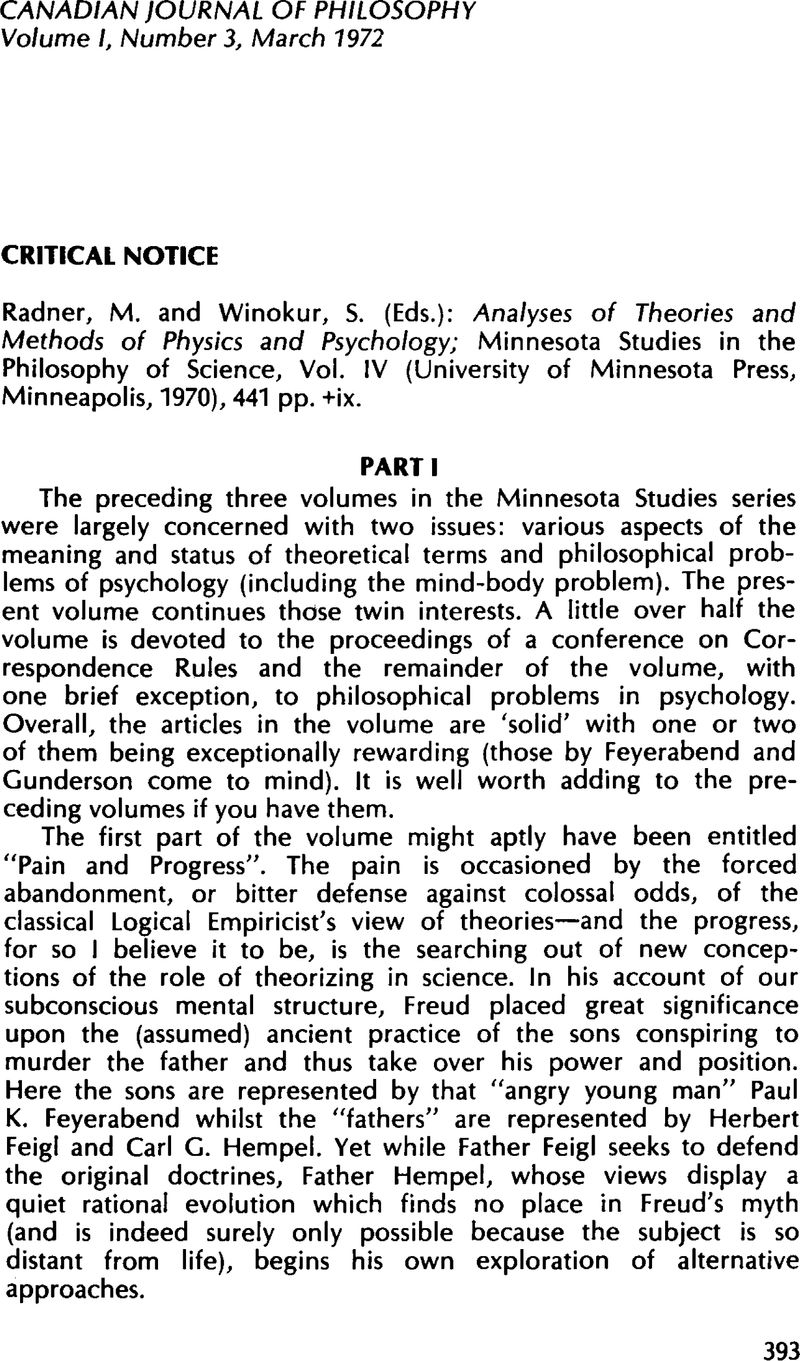Article contents
M. Radner and S. Winokur (Eds.): Analyses of Theories and Methods of Physics and Psychology; Minnesota Studies in the Philosophy of Science, Vol. IV (University of Minnesota Press, Minneapolis, 1970), 441 pp. +ix.
Review products
Published online by Cambridge University Press: 01 January 2020
Abstract

- Type
- Critical Notice
- Information
- Copyright
- Copyright © The Authors 1972
References
1 For the original article see Ramsey, F. P. “Theories” (1929)Google Scholar. In Ramsey, F. P. The Foundations of Mathematitcs (London, Routledge and Kegan Paul, 1931)Google Scholar. Further comments on Ramsey's method may be found in my “Craigian transcriptionism”, American Philosophical Quarterly, 5 (1968) and in footnote 8, p. 149, of the volume under review (Minnesota IV).
2 See Feyerabend, P. K. “An Attempt at a Realistic Interpretation of Experience”, Proceedings of the Aristotelian Society, 58 (1958)CrossRefGoogle Scholar and subsequent papers mentioned, for example, in the notes to Feyerabend's own essay in the volume under review here. For my own effort see “A Realist Doctrine of Perception” to appear in Theory and Decision.
3 His earlier articles are “Studies in the Empiricist Theory of Scientific Meaning”, Philosophy of Science, 27 (1960), pp. 359–73; “The Factual Content of Theoretical Concepts” in H. Feigl and G. Maxwell (eds.), Minnesota Studies in the Philosophy of Science, Vol. III, “Of Selection Operators and Semanticists”, Philosophy of Science, 31 (1964), pp. 282–85.
4 The difficulties involved in following out this semantical programme are nicely illustrated in Rozeboom's Technical Idealization 4b [TI-4b]:
“If state of affairs s is a sufficient condition for there to exist a state of affairs which verifies a sentence T, then s also verifies T.” (p. 215)
At first glance the reader might get the impression that Tl-4b was intended to allow the state of affairs s to verify T if s was only nomicly, or even only accidentally, sufficient for another state of affairs which verifies T. (In this case the idealized conclusion 4 (p. 216) would set a very large gulf indeed between what a theoretical sentence was taken to be about and its truth conditions — as stipulated in Tl-4b). However, a careful reading of Rozeboom's text indicates that he actually has something in mind which is a lot tighter than what Tl-4b suggests. The sense of “sufficient condition” which is wanted here is one which is weaker than classic analytic entailment but stronger than nomic entailment (connection or whatever) and something like this: The truth of a sentence S, designating the state of affairs s, is sufficient for the truth of T when the truth of T is entailed by the truth of S together with information about the semantical properties of S and T. But how exactly to make precise this relationship is something which yet remains to be done.
5 Perhaps even thorough-going, Jungian Archetypal ideas—cf. my comments on Feyerbend in my Critical Notice on his essay in the volume under review here (Minnesota IV) which is to appear in the next issue of this Journal.
6 Cf. my forthcoming article “A Realist Doctrine of Perception” in Theory and Decision, which is sympathetic to the works of Piaget and a great deal of other modern psychological research on perception.
7 Again I counsel the reader to read the discussion at the end of Part I as soon as one has finished reading Hempel's essay. There one finds, for example, a re-expression of Hempel's second concession to Realism on p. 253, a nice distinction made by Achinstein in response and a statement (p. 254) by Feyerabend of the alternative conception of languages and theories which I have been outlining above.
8 See Grunbaum, A. “Space, Time and Falsifiability”, Philosophy of Science, 37 (1970), 469–588.Google Scholar
9 See Popper, K. R. : “Of Clouds and Clocks: An Approach to Rationality and the Freedom of Man”, A. H. Compton Memorial Lecture presented at Washington University, April 21, 1965 (Washington University Press, St. Louis, 1966).Google Scholar
- 2
- Cited by


